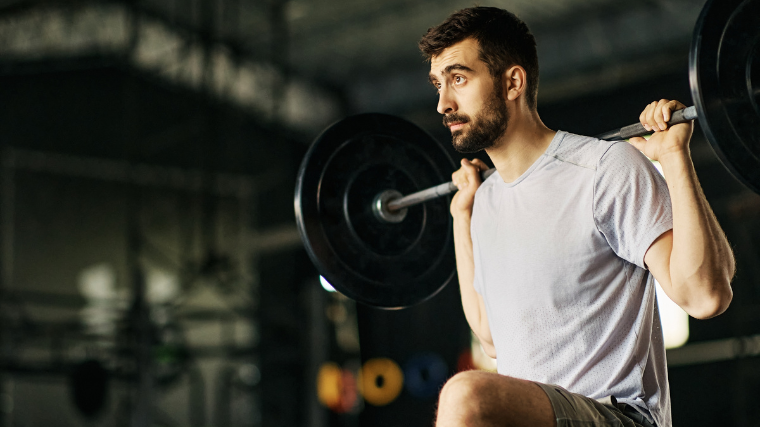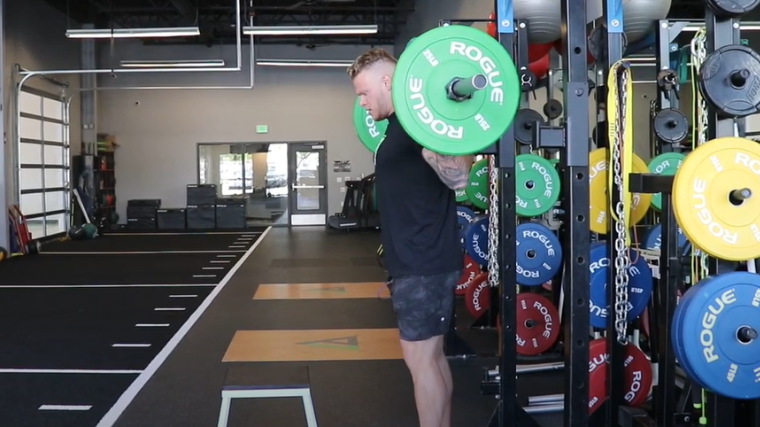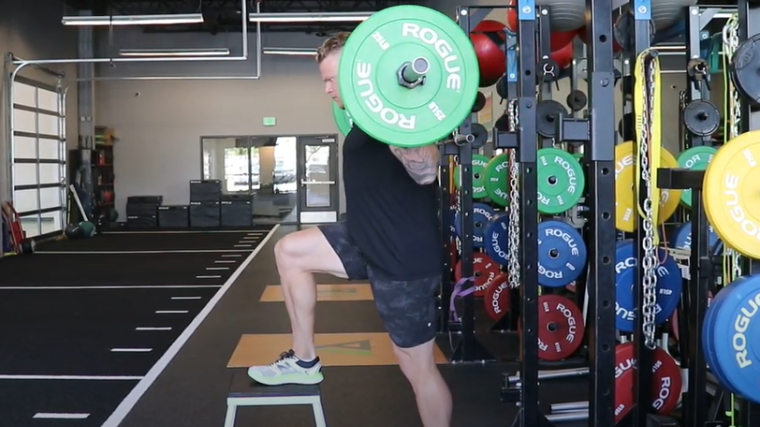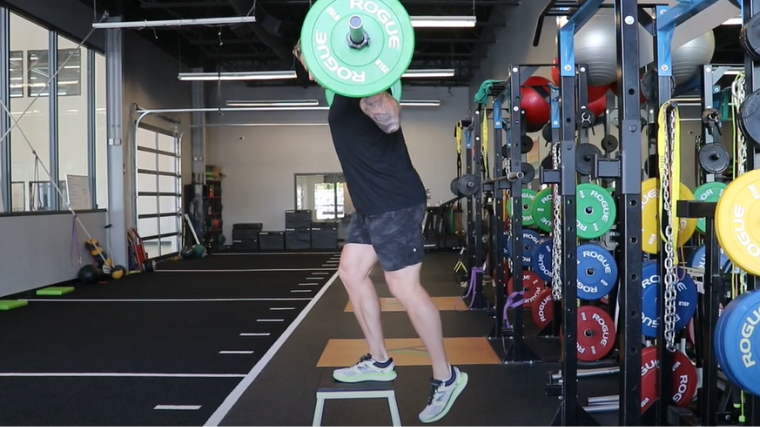You can train your legs in a variety of ways. Squat, pull, lunge, thrust, work on two legs; balance on one. When you lace up your cross-trainers to hit the gym and build your wheels, the movements that go into your routine strongly determine the results you’ll get.
If you’re looking for a single-leg exercise that’s beginner-friendly (but that you can still go hard on) and doesn’t require gymnast-level balancing skills, look no further than the standard step-up. It might just be what you’re missing during your leg workouts.

Here’s how you can use the step-up to elevate your next leg day.
- How to Do the Step-Up
- Step-Up Sets and Reps
- Common Step-Up Mistakes
- Step-Up Variations
- Step-Up Alternatives
- Muscles Worked by the Step-Up
- Benefits of the Step-Up
- Who Should Do the Step-Up
- Frequently Asked Questions
How to Do the Step-Up
As long as you have two legs and an elevated surface, you are good to go with the step-up. However, this guide will teach you how to perform the exercise while using a barbell for resistance.
You also might consider using a plyometric box to step up onto, but any stable surface will do.
Step 1 — Set Yourself Up
Before you can start doing step-ups properly, you need to make sure you have all the right equipment. First, stand in front of a stable, elevated surface; it should be roughly knee-height to begin with.
Place a loaded barbell onto your back and grip it tightly like you would for a squat.
Coach’s Tip: The higher the surface you step up onto, the more hip mobility and leg strength you’ll need.
Step 2 — Lift and Plant Your Foot
Begin the exercise by raising your working leg and planting it firmly onto the box in front of you. Shift the majority of your weight onto that foot, and brace your core as you prepare to drive yourself upward.
Coach’s Tip: Fix your gaze forward; don’t look at your feet.
Step 3 — Drive Your Leg
Once you’ve planted your working foot onto the box, press downward hard with the same foot to lift your entire body upward. You should feel your quads and glutes contract. Step up until your knee and hip lock out and hold that position for a beat.
Coach’s Tip: You can bring your non-working leg up onto the box as well, but don’t allow it to “help” your working leg.
Step 4 — Lower Slowly
Once you’ve paused at the top of the movement with your working leg straightened, reverse the movement and lower yourself back down. Your non-working leg should hang freely behind you as you descend and should make contact with the floor first.
Coach’s Tip: Think of your back leg as a kickstand and use it to balance yourself as you come back down to the ground.
Step-Up Sets and Reps
As a compound, multi-joint leg movement, the step-up is versatile. You can program it for a variety of different purposes depending on your goals. Here are just a few ways to utilize the step-up in your workouts:
- For Muscle Growth: Try 2 to 3 sets of 8 to 10 reps per leg with a moderate weight.
- To Improve Balance: Try 2 sets of 5 to 8 reps with a very slow tempo.
- As a Beginner: Go for 2 sets of 10 reps with no added weight.
Common Step-Up Mistakes
It may not be as complicated as a snatch or squat jerk, but you can definitely mess up the step-up. Make sure you’re side-stepping these common errors if you want to perform the movement properly.
Using a Box That’s Too High
The step-up is meant to challenge your leg strength, balance and coordination, and help you break a sweat along the way. It’s not necessarily a hip mobility exercise, but if you try to step up onto a surface that’s too high, that’s exactly what you’ll have to deal with.
Advanced trainees can work with higher boxes than beginners since it adds range of motion. However, a surface that’s too high can compromise your mechanics or encourage you to utilize your non-working leg to begin the movement.
Allowing Your Back Leg to Assist
You need to think of your non-working leg as a kickstand during the step-up. It’s all too easy to start giving yourself a small push off the ground to initiate the movement — this can rapidly escalate and defeat the purpose of the exercise.
Make sure to keep as much of your weight as possible on your working leg. Allow your “free” leg to hang loosely and only use it to tap the ground for stability on an as-needed basis.
Step-Up Variations
The step-up is great. In fact, you can make it even better with some simple tweaks. Here are a few variations to try out for yourself.
Dumbbell Step-Up
You can load the step-up exercise in any manner you wish, but some forms of external resistance present greater challenges than others.
If you want to load your legs but struggle with your balance, consider swapping the barbell out for a pair of dumbbells instead. Holding the weights on either side of your body closer to your center of mass should make it easier to balance on one leg.
[Read More: Best Dumbbell Workouts]
Bodyweight Step-Up
There’s no reason that you can’t dial down the difficulty on the step-up. Sure, working with a lower box will do the trick, but you can simply use your bodyweight as well.
Bodyweight-only step-ups are a great general warm-up to get your heart going while also mobilizing your hips. Give them a shot before you dive into your next leg day.
Step-Up Alternatives
The step-up is just one of many, many different unilateral leg exercises. If they aren’t your jam, give these alternatives a shot instead.
Walking Lunge
Lunges add a dynamic element to the step-up by forcing you to cover significant distance while also torching your quads. You’ll generally find that lunges tax your cardiovascular system more than step-ups, depending on your cadence and the number of steps you take.
You can perform lunges unweighted for general warm-up purposes, or hold a weight to replace step-ups entirely.
Glute Pushdown
If you want to get creative, you can repurpose an assisted pull-up machine to replicate the motion of the step-up; just in reverse.
Think of the glute pushdown as an inverse of the step-up. Instead of elevating your body by pressing against a stable surface, you use your legs to push down on a moving platform.
The glute pushdown is fantastic if step-ups feel good on your legs and you enjoy the movement pattern, but may not have the balance or cardiovascular capacity to really work hard on the exercise.
Single-Leg Leg Press
The physique-minded might want to try out a single-legged leg press instead of the standard step-up. You’ll find that it works all of the same muscles, but does give your core and cardio a bit of a breather.
In exchange, you can really load up on heavy weights and burn your legs to a crisp one at a time. The single-leg leg press is phenomenal for bodybuilders or those who simply don’t enjoy having to balance themselves on leg day.
Muscles Worked by the Step-Up
The step-up doesn’t work your body from head to toe, but it almost does. Here are some of the major muscles involved in the exercise.
Quads
Your quadriceps consist of several individual muscles that mainly function to extend, or straighten, the knee joint. This is why you’ll find that all manner of squats, lunges, or leg presses burn the front of your thighs.
The step-up is a great quad exercise because it puts those knee extensors in a prime position to perform work. Since you begin the movement with a flexed knee, you have to get yourself off the ground somehow; your quads are in the driver’s seat.
Glutes
Your gluteal muscles primarily extend your hip (think of exercises like the hip thrust and deadlift). However, they’re also put under a great deal of tension during the step-up, particularly through the middle of the movement.
You’ll also find that your glutes have a lot of work to do during the eccentric portion of every rep, as they’re tasked with stabilizing your pelvis in space as you lower yourself down.
Core
The step-up may not be an ab-focused exercise, but you should still expect it to challenge your core to some degree.
Moving your torso in space will involve the musculature on the front and sides of your trunk to help keep you upright and rigid. You can think of your core as the framework that enables your legs to generate force; if the frame is shaky, you can’t take your legs to their limit.
Upper Body
This varies tremendously by what type of external resistance you’re using (if any), but you can get some mild upper body stimulation during the step up as well.
If you opt to hold a pair of dumbbells in each hand, your trapezius muscles will have to contract isometrically to stabilize your shoulder girdle, while your forearms grip the handles of each weight as hard as they can.
Hold a kettlebell in front of your body in a goblet position and your upper back has to perform a similar role. These variations may not be enough to stimulate your upper body fully, but they can add some extra challenge.
Benefits of the Step-Up
Step-ups have a lot to offer. Here are some of the many, many benefits you can expect if you implement them into your training plan.
Targeted Leg Growth
Big squats and pulls are all well and good for growing your legs, but you should probably incorporate a few smaller, sharper tools to get the job done as well.
Not only will step-ups hit your legs in a slightly different manner than most squats, but their unilateral nature allows you to really focus on contracting one quad or glute at a time for maximal hypertrophy.
Helps Address Imbalances
Muscular or strength-based imbalances can wreak havoc on your performance. You may not notice discrepancies here if you exclusively train on two legs, but working with the step-up will expose any problems right away.
Luckily, you can also use the step-up to treat the issue as well. Single-leg movements enable you to bring up a lagging limb by performing more sets, reps, or using a heavier weight as needed.
Trains Your Balance
If you’re interested in developing your balance or bodily coordination, the step-up is a fantastic starting point. The beauty of the movement lies in how easily you can crank up (or dial down) the difficulty by adjusting the height of whatever surface you’re stepping onto.
A higher step elongates the range of motion and asks more of your core as you lower yourself back down. A low step is great for teaching newcomers how to balance unevenly and then apply force through one leg at a time.
Who Should Do the Step-Up
Step-ups bring forward all the best parts of unilateral training while also being plenty relevant for the average gymgoer, dedicated bodybuilder, and rank beginner alike. If you fall into one of these camps, consider adding the step-up to your routine.
Beginners
Those brand-new to the weight room can benefit a great deal from adding an exercise like the step-up to their routine. You’ll generally find that step-ups challenge you in a variety of different ways, without going too hard at your strength or cardiovascular capacity.
As such, they’re a wonderful all-around lower body fitness-builder. Give them a shot if you want to bring up your cardio, leg strength, and balance all at once.
Bodybuilders
Improving your physique is all about finding the right tool for the job. You might want a single-leg exercise in your bodybuilding routine, but simply don’t have the room to perform walking lunges or lack access to a leg press station.
[Read More: The Best Quad Exercises and Quad Workouts for Muscle Gain]
The step-up can be performed just about anywhere and makes for a great leg-builder if you have access to weights as a form of progressive overload.
Get to Stepping
If you’re looking to shape up your legs, the step-up should be your go-to. The best part about the step-up is that you can make it as easy or as difficult as you need it to be.
Brand new to exercise? Grab a low box around shin height and work on your steps. Familiar with working out and on the prowl for a reliable single-leg exercise? Get some weights and step up onto a higher box. You’ll feel the burn in no time. The step-up is good for just about any gym goal, so there’s no good reason to not give it a go.
FAQs
Have some questions before you take your first step with the step-up? No worries. Keep reading to find your answers.
Do I have to use weights with the step-up?
Not necessarily! The step-up is a great calisthenics movement, particularly for beginners or those coming back from a break from exercise. As you become more comfortable with the movement, you can gradually raise the height of the surface you step to before adding weight.
Which leg do I use first during the step-up?
It doesn’t matter all that much. That said, if you want to really focus on balancing your leg strength and size, you can start sets of step-ups with your non-dominant leg. This will ensure you have ample energy to perform quality repetitions when they matter most.
Featured Image: Drazen Zigic / Shutterstock




